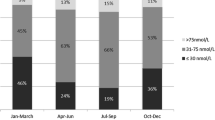Abstract
Vitamin B6 metabolites and their potential correlates to urinary oxalate excretion in idiopathic calcium stone formers (ICSF) compared with healthy subjects were investigated. This clinical study was performed in a population of male ICSF with (Hyperoxalurics, n=55) or without hyperoxaluria (Normooxalurics, n=57) as well as in 100 healthy male control subjects. Pyridoxal 5’-phosphate serum concentration (S-pyridoxal 5’P) and 24-h urinary excretion of 4-pyridoxic acid (U-4pyridoxic acid) were measured using HPLC; 24-h urinary excretion of oxalate (U-oxalate) was measured concurrently. A subgroup of subjects (40 Hyperoxalurics, 15 Normooxalurics and 50 controls) underwent the same measurements before and after 7-day pyridoxine loading per os (pyridoxine hydrochloride, 300 mg/d). Under usual conditions, U-4pyridoxic acid was similar in the three groups, whereas mean S-pyridoxal 5’P was significantly lower (p<0.0001) in the Hyperoxalurics (59.6±21.2 nmol/L) and in the Normooxalurics (64.9±19.7 nmol/L) than in the controls (86.0±31.0 nmol/L). No correlation could be found between U-oxalate and U-4pyridoxic acid or S-pyridoxal 5’P. After B6 loading, S-pyridoxal 5’P was still significantly lower in the Hyperoxalurics (415±180 nmol/L, p<0.001) and in the Normooxalurics (429±115 nmol/L, p=0.036) than in the controls (546±180 nmol/L), although there was no difference between groups for U-4pyridoxic acid. No correlation in any group could be found between changes in U-oxalate and changes in U-4pyridoxic acid or S-pyridoxal 5’P. Although there is no vitamin B6 deficiency in ICSF with or without hyperoxaluria, these patients, on average, have lower levels of S-pyridoxal 5’P than healthy subjects. However, this slight decrease does not seem to account for idiopathic hyperoxaluria.



Similar content being viewed by others
References
Pak C (1993) Urolithiasis. In: GC, Schrier RW (eds) Little, Brown and Company, Boston, Toronto, London pp 729–741
Holmes R, Goodman H, Assimos D (2001) Contribution of dietary oxalate to urinary oxalate excretion. Kidney Int 59:270–276
Milliner D, Eickholt J, Bergstralh E, Wilson D, Smith L (1994) Results of long-term treatment with orthophosphate and pyridoxine in patients with primary hyperoxaluria. N Engl J Med 331:1553–1558
Gershoff S (1970) Production of urinary calculi in vitamin B6 deficient male, female and castrated male rats. J Nutr 100:117–122
Schneider H, Hesse A, Berg W, Kirsten J, Nickel H (1977) Tierexperimentelle Untersuchungen über die Wirkung von Magnesium und Vitamin B6 auf die Kalziumoxalatnephrolithiasis. Zschr Urol 70:419–427
Gershoff S, Prien E (1967) Effect of daily MgO and vitamin B6 administration to patients with recurring calcium oxalate kidney stones. Am J Clin Nutr 20:393–399
Rattan V, Sidhu H, Vaidyanathan S, Thind S, Nath R (1994) Effect of combined supplementation of magnesium oxide and pyridoxine in calcium-oxalate stone formers. Urol Res 22:161–165
Mitwalli A, Ayiomamitis A, Grass L, Oreopoulos D (1988) Control of hyperoxaluria with large doses of pyridoxine in patients with kidney stones. Int Urol Nephrol 20:353–359
Jaeger P, Portmann L, Jacquet A, Burckhardt P (1986) La pyridoxine peut normaliser l’oxalurie dans la lithiase rénale idiopathique. Schweiz Med Wschr 116:1783–1786
Amato M, Donzelli S, Lombardi M, Salvadori M, Carini M, Selli C, Caudarella R (1987) Primary hyperoxaluria: effect of treatment with vitamin B6 and shock waves. Contr Nephrol 58:190–192
Alinei P, Guignard J, Jaeger P (1984) Pyridoxine treatment of type 1 hyperoxaluria. N Engl J Med 311:798–799
Will E, Bijvoet O (1979) Primary Oxalosis: clinical and biochemical response to high-dose pyridoxine therapy. Metabolism 28:542–548
Robertson W, Peacok M, Heyburn P, Marshall D, Clark P (1978) Risk factors in calcium stone disease of the urinary tract. Br J Urol 50:449–454
Nguyen Q, Kälin A, Drouve U, Casez J, Jaeger P (2001) Sensitivity to meat protein intake and hyperoxaluria in idiopathic calcium stone formers. Kidney Int 59:2273–2281
Bai S, Sampson D, Morris J, Rogers Q (1991) The level of dietary protein affects the vitamin B6 requirement of cats. J Nutr 121:1054–1061
Buttery JE, Ludvigsen M, Braiotta EA, Pannal PR (1983) Determination of urinary oxalate with commercially available oxalate oxidase. Clin Chem 29:700–702
Yendt E, Cohanim M (1985) Response to a physiologic dose of pyridoxine in type I primary hyperoxaluria. N Engl J Med 312:953–957
Gershoff S, Faragalla F, Nelson D, Andrus S (1959) Vitamin B6 deficiency and oxalate nephrocalcinosis in the cat. Am J Med 72–80
Edwards P, Rose G (1991) Metabolism of pyridoxine in mild metabolic hyperoxaluria and primary hyperoxaluria (type 1). Urol Int 47:113–117
Tiselius H, Almgård L (1977) The diurnal urinary excretion of oxalate and the effect of pyridoxine and ascorbate on oxalate excretion. Eur Urol 3:41–46
Nakano H, Gregory J (1995) Pyridoxine and pyridoxine-5’-beta-D-gucoside exert different effects on tissue B6 vitamers but similar effects on beta-glucosidase activity in rats. J Nutr 125:2751–2762
Author information
Authors and Affiliations
Corresponding author
Rights and permissions
About this article
Cite this article
Kaelin, A., Casez, JP. & Jaeger, P. Vitamin B6 metabolites in idiopathic calcium stone formers: no evidence for a link to hyperoxaluria. Urol Res 32, 61–68 (2004). https://doi.org/10.1007/s00240-003-0386-2
Received:
Accepted:
Published:
Issue Date:
DOI: https://doi.org/10.1007/s00240-003-0386-2




